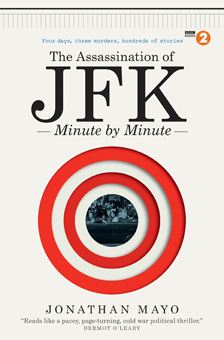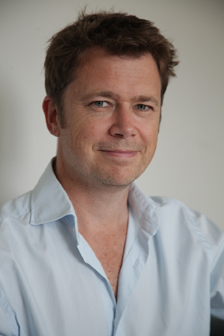Mementoes of JFK
by Jonathan MayoThe assassination of John F. Kennedy on 22 November 1963 has become a cliché. We are overfamiliar with the Zapruder footage of the moment of his death in a way inconceivable to those who lived through it. Fifty years ago, “where were you when Kennedy died?” was a question to inspire hushed conversation about a shared horror. Now it is prompted by mild curiosity. In The Assassination of JFK: Minute by Minute I aim to restore the impact of the killing of Kennedy, by telling the stories of the hundreds of people caught up in the drama of that long and terrible weekend. Kennedy himself is not the key figure in the book, but he is a person who fascinates me – the rich playboy who discovered his political instincts not on the hustings, not even on Capitol Hill – but in the Oval Office. What follows below is a selection of documentation and ephemera surrounding the events of the killing.
Most memorable photograph
There were of course three murders over that infamous November weekend – Kennedy’s, Officer J.D. Tippit’s (shot by Oswald when he stopped the latter for questioning 45 minutes after the assassination) and Lee Harvey Oswald’s. The moment Jack Ruby killed the president’s assassin is famously captured in Bob Jackson’s photograph that shows Oswald grimacing as Ruby thrusts the gun in his side and fires. Jackson won a Pulitzer for it. Yet I prefer the one taken literally a split second earlier, by Jack Beers of the Dallas Morning News. It shows the moment just before Jack Ruby shoots. He’s stepping forward, gun raised. On the left is a line of plain-clothes policemen; on the right, reporters in raincoats are holding their microphones out to Oswald. No one is looking at the man in the dark suit and hat with a gun – all eyes are on Oswald, striding between detectives Leavelle and Graves. Oswald looks ahead. It’s said that Jack Beers never really got over the fact that he missed the moment and Jackson got the glory – but for me, Beers’ picture is the better one for capturing the moment before. Read more.
TV moment
Abraham Zapruder, the Dallas dressmaker who shot the famous footage of the assassination, appeared on television himself that day. About two hours after the shooting in the news studio of WFAA-TV, presenter Jay Watson is half listening to the director in his earpiece and half listening to Zapruder’s eyewitness account of the shooting. He suddenly turns and gives the man his full attention when he describes the impact of the final bullet. “I saw his head practically open up, all blood and everything and I kept on shooting. That’s about all of it. I’m just sick of it, kid,” Abraham Zapruder says, as he fights back tears. “I think that pretty well expresses the entire feelings of the whole world,” replies Watson, “you have the film in your camera… we’ll try to get that processed and have it as soon as possible.”
Gary Delaune’s radio report
For me, no piece of radio archive conveys the excitement, terror and sheer adrenaline rush of the murder in Dealey Plaza like KLIF Radio’s live report by Gary Delaune, seconds after the shots were fired. Delaune was stationed further along the motorcade route with his radio car, expecting to commentate on the motorcade as it drove past. Instead the limousine flew by at 80 miles an hour on its way to Parkland Hospital. As Delaune talks you can hear the wail of sirens.
“Put me on, Phil! Put me on! Phil, am I on? We’re here at the Trade Mart… The presidential car coming up now… we can see Mrs Kennedy’s pink suit, there’s a secret service man spread-eagled over the top of the car… we can’t see who’s been hit, if anybody’s been hit, but apparently something is wrong here, something is terribly wrong…”
The Black Watch
There was a British presence at Kennedy’s funeral – other than Prince Philip and Peter Lawford, JFK’s brother-in-law (or ‘Brother-in-Lawford’ as Frank Sinatra dubbed him.) The Scottish Black Watch regiment had performed for the Kennedy family on the White House lawn a few days before his death, and after JFK’s assassination Jackie, recalling how much he loved their music, invited them to play at his funeral. As they marched through the streets of Washington on Monday 25 November, some of the pipers were covered in cuts and bruises. On the evening of the assassination they had been in a bar in Kentucky and had encountered some men who were pleased that Kennedy had been killed. A fight ensued as the pipers defended the good name of the president.
Favourite quote
As Kennedy’s casket made it’s way through the streets of Washington on its way to Arlington Cemetery a lady called out, “That’s all right, you done your best; it’s all over now.”
Thirteen Days by Roger Donaldson
Not as successful as Oliver Stone’s JFK, the film Thirteen Days (2000) tells the story of Kennedy’s handling of the 1962 Cuban Missile Crisis. It’s gripping and sticks broadly to the facts – where the film JFK doesn’t. Oliver Stone persists in the idea that Jim Garrison has a credible take on the assassination. He is Garrison’s patsy. Thirteen Days is worth seeking out. It shows how Kennedy learned from the fiasco of the Bay of Pigs and how his experiences in World War II shaped his mistrust of the chiefs of staff who were keen on a missile strike on Cuba. Kevin Costner is excellent as Kenny O’Donnell, the President’s special assistant. It would be O’Donnell who would go on to plan the Dallas trip the following year – which left him with a sense of guilt that led to his early death through alcoholism.

The Death of a President first edition (Harper Row, 1967)
The Death of a President by William Manchester
This book is in the tradition of A Night to Remember and The Longest Day – taking an historical event and giving it the feel of a novel. Published in 1967, The Death of a President kicks out dull historical description and stays strong on anecdote and detail. It was an invaluable source book for me. In February 1964 Jackie Kennedy asked Manchester to write the book as her husband knew and liked his work. He conducted interviews with almost all the key players in the assassination drama, including 10 hours of interviews with Jackie herself. But in the end she tried to stop it getting published, allegedly because it was too critical of Lyndon Johnson… and it revealed that she smoked.
Favourite conspiracy theory
So many crazy ones to choose from… how about one favoured by Marguerite Oswald, Lee’s mother? She believed that her son had been paid by the CIA to kill the president as a ‘mercy killing’ because Kennedy was terminally ill. For reasons best known to herself, Marguerite had a plaque made for her house which said, “My son Lee Harvey Oswald even after his death has done more for his country than any other living human being.”
Favourite song
The murder of Kennedy prompted many songs. The Beach Boys were writing The Warmth of the Sun that morning and rewrote the lyrics in the afternoon. On a live That Was The Week That Was the next day, Millicent Martin sang, against the backdrop of a sunset, a piece written that afternoon by Herbert Kretzmer called In The Summer of His Years. A tear ran down her cheek when she finished it. But the best of all was written five years later by Dick Holler in the aftermath of Robert Kennedy’s death – Abraham, Martin and John linked four American deaths in one song. The best performance for me was by Andy Williams on his LP Happy Heart. It may be because he was a close friend of Bobby Kennedy.
Best supporting role
Lieutenant Sam Bird was in charge of guarding Kennedy’s body from its arrival at Andrew’s Air Force base to the burial at Arlington. I’d like to have met him; he was thoughtful, observant and clearly a bit of a worrier. Concerned that the honour guard would not be able to cope with the weight of the casket, the night before the funeral he got his six men to rehearse with a replica casket filled with sandbags, marching up and down a flight of stone steps. Still not happy, Bird asked an off-duty sentry to sit on the casket. Even this was not enough for Lieutenant Bird – he then joined the sentry on top. Needless to say, on the day the honour guard carried the casket flawlessly.
Jonathan Mayo is a freelance TV and radio producer. His 2012 documentary Titanic: Minute by Minute won the Grand Award at the New York Festival. His live documentary The JFK Assassination: Minute by Minute was broadcast on BBC Radio 2 on Friday 22 November 2013 from 6 pm, exactly fifty years since the events unfolded, presented by Jeremy Vine and Dermot O’Leary.
The Assassination of JFK: Minute by Minute is published by Short Books.
Read more.



